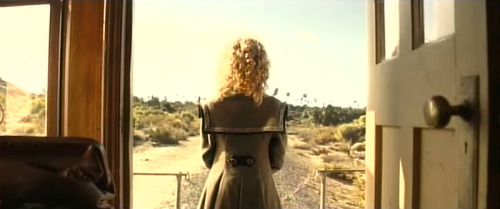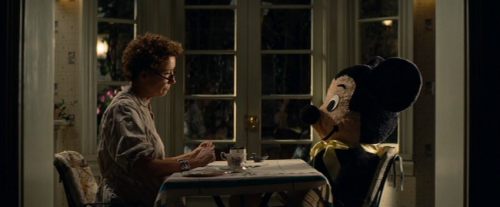 The Oscar Nominations are out and Thomas Newman's work in "Saving Mr. Banks" is up for an Academy award for Best Original Score. As soon as I walked out of the theater I told my friends that the score was amazing so while I'm not entirely surprised, I am definitely thrilled to hear about the nomination. I'm not a huge film buff so I don't usually follow awards season but I've always taken an interest in this category as a musician. The role of the orchestral score, like any other element of the film like the script, actors and cinematography, is to tell a story. It helps to define a mood and tone for the film. Music has the ability to completely transform scenes and it's my favorite part of analyzing a film.
The Oscar Nominations are out and Thomas Newman's work in "Saving Mr. Banks" is up for an Academy award for Best Original Score. As soon as I walked out of the theater I told my friends that the score was amazing so while I'm not entirely surprised, I am definitely thrilled to hear about the nomination. I'm not a huge film buff so I don't usually follow awards season but I've always taken an interest in this category as a musician. The role of the orchestral score, like any other element of the film like the script, actors and cinematography, is to tell a story. It helps to define a mood and tone for the film. Music has the ability to completely transform scenes and it's my favorite part of analyzing a film. And I can absolutely guarantee you that you've heard Newman's work before. He has had a long and illustrious career providing the soundtracks to such films as Finding Nemo, WALL-E, A Series of Unfortunate Events, The Help (starring Emma Stone) and of course the latest Bond film-Skyfall. Newman is actually one of my favorite film composers (alongside Alan Menken, Alan Silvestri and Michael Giacchino). If I wanted a composer to write the soundtrack to my life, it would definitely be Thomas Newman because his work is often very subtle but still strikes a perfect balance between being fanciful and warm. His tracks do a wonderful job of supporting the storyline and actors because they fit into the scene so wonderfully that you could hardly imagine the scenes without them.
And I can absolutely guarantee you that you've heard Newman's work before. He has had a long and illustrious career providing the soundtracks to such films as Finding Nemo, WALL-E, A Series of Unfortunate Events, The Help (starring Emma Stone) and of course the latest Bond film-Skyfall. Newman is actually one of my favorite film composers (alongside Alan Menken, Alan Silvestri and Michael Giacchino). If I wanted a composer to write the soundtrack to my life, it would definitely be Thomas Newman because his work is often very subtle but still strikes a perfect balance between being fanciful and warm. His tracks do a wonderful job of supporting the storyline and actors because they fit into the scene so wonderfully that you could hardly imagine the scenes without them.In this film, Newman has to negotiate two different settings. The film takes place both in 1960's California and turn of the century Allora, Queensland. These two locations are completely different and the accompanying music needed to demonstrate that as well.
 The Walt Disney Studios were moving forward, modern and to a certain extent....superficial. There are a few original tracks from the period incorporated into the soundtrack. Heigh Ho was the swing version of the song from Snow White recorded in 1957. This was a few years before the film takes place but I think it's nice to characterize the more casual and liberally creative ambience. Taking a classic and improvising it into a new style is exactly what a lot of jazz musicians do. However, deviating from the original is exactly what P. L. Travers is afraid that the creative team at Disney is going to do to her story and she is terrified of that. One Mint Julep by Ray Charles was also featured in the soundtrack to underscore the bold, bombastic nature of California or at least as it appears to P. L. Travers. I think that it was definitely a good choice to include these because it lends a certain authenticity to those scenes.
The Walt Disney Studios were moving forward, modern and to a certain extent....superficial. There are a few original tracks from the period incorporated into the soundtrack. Heigh Ho was the swing version of the song from Snow White recorded in 1957. This was a few years before the film takes place but I think it's nice to characterize the more casual and liberally creative ambience. Taking a classic and improvising it into a new style is exactly what a lot of jazz musicians do. However, deviating from the original is exactly what P. L. Travers is afraid that the creative team at Disney is going to do to her story and she is terrified of that. One Mint Julep by Ray Charles was also featured in the soundtrack to underscore the bold, bombastic nature of California or at least as it appears to P. L. Travers. I think that it was definitely a good choice to include these because it lends a certain authenticity to those scenes.
Furthermore, it's also worth mentioning that Jason Schwartzman and BJ Novak recorded snippets from some of the original tracks from Mary Poppins. These are played as the Sherman brothers wrote some of the songs that would become iconic. I really liked seeing the creative process and I think hearing unfinished versions of the songs helped to hammer home how awful it would have been had the film never been made.
The orchestral tracks by Newman used in the California and the Disney Studio scenes are as follows: Jollification, The Mouse, Mr. Disney, Beverly Hills Hotel, Penguins, Maypole, The Magic Kingdom. Not to give too much away but I think these sets of tracks are an interesting mix of the whimsical but also use a driving rhythm to build a sense of anticipation and excitement. Mr. Disney and The Magic Kingdom are both prime examples of the latter. Let it not be said that Newman can't do bolder tracks because both of these two pieces use the full drum section as well as the entire range of the orchestra to drive the music along and give it energy. It gives the listener the feeling that exciting things are happening and that there will be wonderful creative things to look forward to. And in the case of Mr. Disney, I think that the purpose of his pieces was the define Walt Disney as a character and to draw a further contrast to P. L. Travers. Where Travers is traditional, Walt Disney is innovative. Where she is disagreeable and mysterious, he is charming and has a larger than life personality. Where Travers is holding on to her past, Walt Disney is looking to the stories of the future. Even with these, the most vigorous tracks on the soundtrack, I never felt overwhelmed by the volume or breadth of the music.
 By contrast, Newman takes a rather different tone with the music that backs the childhood memories of P. L. Travers. Certainly the Australia setting is more of a fairy tale setting than California so it makes sense there is a whimsy to these tracks and the use of the celesta helps to emphasize that nicely. However, this story didn't have a happy ending. The adults in her life disappointed Travers time and time again so there is also a sadness and gravitas to some of the pieces. The first track that we are introduced to in the beginning is an arrangement of Chim Chim Cher-ee with a voiceover track of the first lines from Mary Poppins spoken by Travers' father. The other tracks that comprise the Australia scenes are as follows: Travers Goff, Walking Bus, Uncle Albert, Celtic Soul, A Foul Fowl, Laying Eggs, Whiskey, To My Mother, Westerly Weather and Pears. These are definitely more subdued than the California tracks and I can definitely see the parallels between Newman's previous work with Finding Nemo and A Series of Unfortunate Events. He tends to use alternate between the use of a piano to establish the melody and then brings in the entire orchestra to answer it. One of my favorite things about Newman's compositions is that he uses instruments that don't normally get a lot of use in other scores. He make extensive use of the wind sections in these tracks as well as the glockenspiel and harp to emphasize the fairytale-esque aspect of the Allora scenes. They are heartachingly beautiful and truly transport you into a different make-believe realm. Rest assured though, strings are used to create drama and substance in those scenes where the fairytale begins to crumble.
By contrast, Newman takes a rather different tone with the music that backs the childhood memories of P. L. Travers. Certainly the Australia setting is more of a fairy tale setting than California so it makes sense there is a whimsy to these tracks and the use of the celesta helps to emphasize that nicely. However, this story didn't have a happy ending. The adults in her life disappointed Travers time and time again so there is also a sadness and gravitas to some of the pieces. The first track that we are introduced to in the beginning is an arrangement of Chim Chim Cher-ee with a voiceover track of the first lines from Mary Poppins spoken by Travers' father. The other tracks that comprise the Australia scenes are as follows: Travers Goff, Walking Bus, Uncle Albert, Celtic Soul, A Foul Fowl, Laying Eggs, Whiskey, To My Mother, Westerly Weather and Pears. These are definitely more subdued than the California tracks and I can definitely see the parallels between Newman's previous work with Finding Nemo and A Series of Unfortunate Events. He tends to use alternate between the use of a piano to establish the melody and then brings in the entire orchestra to answer it. One of my favorite things about Newman's compositions is that he uses instruments that don't normally get a lot of use in other scores. He make extensive use of the wind sections in these tracks as well as the glockenspiel and harp to emphasize the fairytale-esque aspect of the Allora scenes. They are heartachingly beautiful and truly transport you into a different make-believe realm. Rest assured though, strings are used to create drama and substance in those scenes where the fairytale begins to crumble.Overall I think that Newman did a fantastic job of capturing the two aspects of the story, both the theatricality of California studios and the sentimentality surrounding Travers' childhood in Allora. Of course, it's always hard to tell whether or not a film will win Best Score since these things are highly political. However if it does, it will be incredibly well deserved.

No comments:
Post a Comment